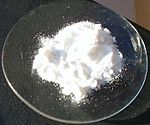Nai
|
|
|||
| Identifiers | |||
|---|---|---|---|
|
7681-82-5 13517-06-1 (dihydrate) |
|||
| 3D model (Jmol) | Interactive image | ||
| ChEBI |
CHEBI:33167 |
||
| ChEMBL |
ChEMBL1644695 |
||
| ChemSpider |
5048 |
||
| ECHA InfoCard | 100.028.800 | ||
| PubChem | 5238 | ||
| RTECS number | WB6475000 | ||
| UNII |
F5WR8N145C |
||
|
|||
|
|||
| Properties | |||
| NaI | |||
| Molar mass | 149.89 g/mol | ||
| Appearance | white solid deliquescent |
||
| Odor | odorless | ||
| Density | 3.67 g/cm3 | ||
| Melting point | 661 °C (1,222 °F; 934 K) | ||
| Boiling point | 1,304 °C (2,379 °F; 1,577 K) | ||
| 158.7 g/100 mL (0 °C) 184.2 g/100 mL (25 °C) 227.8 g/100 mL (50 °C) 294 g/100 mL (70 °C) 302 g/100 mL (100 °C) |
|||
| Acidity (pKa) | 8–9.5 | ||
| −57.0·10−6 cm3/mol | |||
|
Refractive index (nD)
|
1.7745 | ||
| Structure | |||
| Halite | |||
| Octahedral | |||
| Thermochemistry | |||
|
Std molar
entropy (S |
91 J·mol−1·K−1 | ||
|
Std enthalpy of
formation (ΔfH |
−288 kJ·mol−1 | ||
| Hazards | |||
| Main hazards | Irritant, can harm the unborn child | ||
| Safety data sheet | [1] | ||
| Flash point | Non-flammable | ||
| Related compounds | |||
|
Other anions
|
Sodium fluoride Sodium chloride Sodium bromide Sodium astatide |
||
|
Other cations
|
Lithium iodide Potassium iodide Rubidium iodide Caesium iodide Francium iodide |
||
|
Except where otherwise noted, data are given for materials in their standard state (at 25 °C [77 °F], 100 kPa).
|
|||
|
|
|||
| Infobox references | |||
Sodium iodide (chemical formula NaI) is the salt of sodium and iodide. It is a white, crystalline solid that is used mainly as a nutritional supplement and in organic chemistry. It is produced industrially by acidic iodides and sodium hydroxide.
Sodium iodide, as well as potassium iodide, is commonly used to treat and prevent iodine deficiency. Iodized table salt contains one part sodium or potassium iodide to 100,000 parts of sodium chloride.
Sodium iodide is used for conversion of an alkyl chlorides into an alkyl iodides. This method, the Finkelstein reaction, relies on the insolubility of sodium chloride in acetone to drive the reaction:
Some radioactive iodide salts of sodium, including [125I]NaI and [131I]NaI, have radiopharmaceutical uses, such as in the treatment of thyroid cancer and hyperthyroidism or as radiolabeling tracers in imaging (see Isotopes of iodine > Radioiodines I-123, I-124, I-125, and I-131 in medicine and biology).
Sodium iodide activated with thallium, NaI(Tl), when subjected to ionizing radiation, emits photons (i.e., scintillate) and is used in scintillation detectors, traditionally in nuclear medicine, geophysics, nuclear physics, and environmental measurements. NaI(Tl) is the most widely used scintillation material. The crystals are usually coupled with a photomultiplier tube, in a hermetically sealed assembly, as sodium iodide is hygroscopic. Fine-tuning of some parameters (i.e., radiation hardness, afterglow, transparency) can be achieved by varying the conditions of the crystal growth. Crystals with a higher level of are used in X-ray detectors with high spectrometric quality. Sodium iodide can be used both as single crystals and as polycrystals for this purpose. The wavelength of maximum emission is 415 nm.
...
Wikipedia


